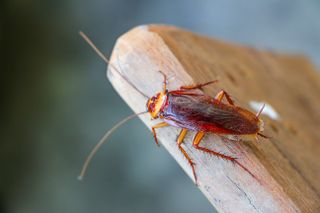A Cockroach Crawled Inside a Woman's Ear, and It Can Happen to You

Another day, another story about an insect crawling into a person's ear and making itself at home.
Katie Holley, a Florida resident, woke up in the middle of the night to a weird sensation in her ear, "like someone had placed a chip of ice in my left earhole," she wrote in an essay published in Self magazine. At first, her husband tried to remove the invader with tweezers. But that strategy wasn't successful, so they went to the emergency room. There, the doctor confirmed her suspicion: A cockroach was in her ear canal. To get the insect out, he first killed it with lidocaine (a numbing agent) and then removed it using tweezers.
But in the days that followed, Holley had soreness in her ear and trouble hearing. When she returned to the doctor nine days later, she learned that she still had pieces — including the entire head — of the roach lodged in her ear. [Gallery: Out-of-This-World Images of Insects].
If you're thinking "gross," you're not alone.
Unfortunately, insects crawling into ears appears to be more common than you'd hope, according to some doctors who talked to Self. (Not so common, though, that you should lose sleep over it).
While there are no recent studies that aim to quantify the icky instances, one small study, published in 2006 the South African Medical Journal, found that during a two-year period, the Tygerberg Hospital in Cape Town, South Africa, removed 23 insects (and one tick) from people's ears. Those insects included three beetles, eight flies and 10 German cockroaches.
And in 2014, emergency-room doctors in Taiwan found a batch of fruit-fly larvae in a woman's ear canal. The 48-year-old had sought medical care because she had severe ear pain, Live Science reported at the time. Another case in Taiwan from 2012 involved a man who itched for two months because he had mites in his ears— a condition that's familiar enough to earn it a medical name: otoacariasis, according to a study published in 2016 in the Journal of Otology. (Otoacariasis isn't limited to mites; it can also be caused by ticks, the study said.)
Sign up for the Live Science daily newsletter now
Get the world’s most fascinating discoveries delivered straight to your inbox.
If you do think you have an insect in your ear, take this advice from the National Institutes of Health (NIH): Try keeping the ear with the insect in it pointing upward in the hope it crawls or flies out or pouring mineral, olive or baby oil into your ear to suffocate the bug and let it potentially float out. And as Holley did, the NIH recommends visiting a doctor even if you pull out the insect on your own, because legs or other parts could be left behind and cause infections.
Originally published on Live Science.

Yasemin is a staff writer at Live Science, covering health, neuroscience and biology. Her work has appeared in Scientific American, Science and the San Jose Mercury News. She has a bachelor's degree in biomedical engineering from the University of Connecticut and a graduate certificate in science communication from the University of California, Santa Cruz.
Most Popular

